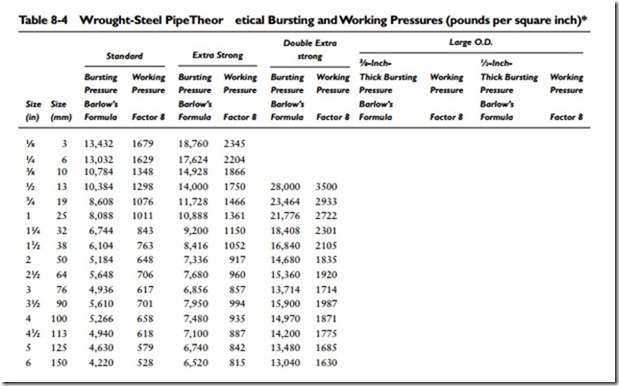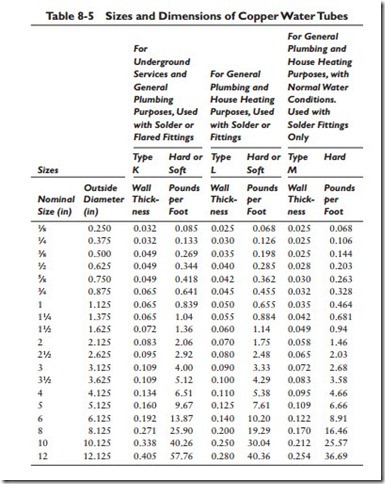Wrought-Steel Pipe
Wrought-steel pipe is cheaper than wrought-iron pipe and consequently is used more widely in heating, ventilating, and air-conditioning than the latter. Depending on the method of manufacture, wrought-steel pipe is available as either welded pipe or seamless pipe. Seamless wrought-steel pipe finds frequent application in high-pressure work.
The wall thickness and weights of wrought-steel pipe are approximately the same as those for wrought-iron pipe. As with wrought-iron pipe, the two most commonly used weights are standard and extra strong. Theoretical bursting and working pressures for wrought-steel pipe are listed in Table 8-4.
In some systems, steel piping has lasted as long as 80 years without showing signs of deterioration. When installed properly, steel piping and tubing are not subject to leakage. Most problems with floor systems occur with steel pipe or tubing installed in a single-pour slab. The stresses that can develop in this type of construction can sometimes damage the pipes or tubing in the radiant floor panels. This does not seem to be the case if the pipes or tubing is installed between the two sections of a two-pour slab or above a concrete slab and beneath a wood floor.
Armco plastic-coated steel, cold-rolled or extruded steel, and stainless steel are among the types of steels currently used in the manufacture of tubing for hydronic heating systems.
Galvanized Pipe
Galvanized steel or iron pipe is covered with a protective coating to resist corrosion. This type of pipe is often used underground or in other areas subject to corrosion. The coating is not permanent, and care should be used when handling it to avoid nicks and scratches. If the surface coating is broken, corrosion will begin that much sooner. Galvanized pipe is cheaper than copper pipe but more expensive than either wrought-iron or wrought-steel pipe.
Caution
Galvanized pipe and galvanized fittings are not recommended for use in steam heating systems.
Copper and Brass Pipes and Tubing
Copper and brass are used in the manufacture of both pipes and tubes and find their greatest application in air-conditioning, refrig- eration, and hydronic radiant floor heating systems. One major advantage of using copper or brass is that both metals are corrosion resistant.
Sometimes the terms copper tube and copper pipe are used inter- changeably as if they were synonymous. Another semantic idiosyn- crasy is to refer to the same product as tube or tubing when still on the inventory at the supply house, but as pipe or piping when installed. Both usages can be confusing because there are differences between the two. For example, copper pipe is often made thicker than tubing because it can be used with threaded fittings if soldering is not desired for making the joint connection. Another point to remember is that copper pipes have the same outside diameters as standard steel pipes. Copper tubing, on the other hand, is standardized on the basis of use into three standard wall-thickness schedules (see Table 8-5): (1) Type K, (2) Type L, and (3) Type M. Type L and Type M are used in heat- ing, ventilating, and air-conditioning systems.
Copper tubing is available as hard-grained (drawn) copper tubes or soft (annealed) copper tubes. The former is subject to freezing, which can cause the tubes to twist in almost the same way as steel pipes. On the other hand, the stiffness of hard-grained copper tubes enables them to hold their shape better than the softer ones. They are, therefore, often used for exposed lines such as mains hung from the ceiling.
The soft-tempered Type L copper tubing is recommended for hydronic radiant heating panels. Because of the relative ease with which soft copper tubes can be bent and shaped, they are espe- cially well adapted for making connections around furnaces, boil- ers, oil-burning equipment, and other obstructions. This high workability characteristic of copper tubing also results in reduced installation time and lower installation costs. Copper tubing is produced in diameters ranging from 1⁄8 inch to 10 inches and in a variety of different wall thicknesses. Both copper and brass fittings are available. Hydronic heating systems use small tube sizes joined by soldering.
The DIN Rating System
Oxygen from the outside air can permeate the tubing material and enter the hydronic system where it will corrode iron and steel components (boiler, fittings, valves, and so on). In the early 1990s, American tubing manufacturers decided to adopt the German DIN Standard 4726 as a uniform rating system. DIN stands for Deutsche (German) Industry Norm. The DIN Standard 4726 requires that hydronic systems not permit the entry of more than one-tenth of a milligram of oxygen per liter of water per day when the water is 104°F (40°C). All of the tubing used in hydronic heating systems must meet this standard.
Plastic Tubing
Both cross-linked polyethylene tubing and polybutylene tubing are used in modern hydronic radiant panel heating systems. The former is by far the more popular of the two. The tubing is available in coils.
Some plastic tubing may become hardened and brittle after long use. If the tubing is then subjected to sudden unusual high pressures, such as those caused by boiler, valve, or other system component failures, cracks form and leakage occurs. Long cracks or fractures along a tubing circuit are not considered repairable to code.
Normal temperature differences in a hydronic system will cause the plastic tubing to expand and contract. This expansion and con- traction over a long period of time eventually causes cracks or frac- tures to develop in the tubing, especially if it is already weakened by age or other factors. Expansion and contraction at the joints and connections between the tubing and the system boiler and mani- folds may also cause leakage.
Cross-Linked Polyethylene Tubing
Cross-linked polyethylene (PEX) tubing is commonly used indoors in hydronic radiant heating panels or outdoors embedded beneath the surface of driveways, sidewalks, and patios to melt snow and ice. It is made of a high-density polyethylene plastic that has been subjected to a cross-linking process. It is flexible, durable, and easy to install. There are two types of PEX tubing:
• Oxygen barrier tubing
• Nonbarrier tubing
Oxygen barrier tubing (BPEX) is treated with an oxygen barrier coating (EVOH) to prevent oxygen from passing through the tubing wall. It is designed specifically to prevent corrosion to any ferrous fittings or valves in the piping system. BPEX tubing is recommended for use in hydronic radiant heating system.
Nonbarrier tubing should be used in a hydronic radiant heating system only if it can be isolated from the ferrous components by a corrosion-resistant heat exchanger, or if only corrosion-resistant system components (boiler, valves, and fittings) are used.
PEX tubing is easy to install. Its flexibility allows the installer to bend it around obstructions and into narrow spaces. A rigid plastic cutter tool, or a copper tubing cutter equipped with a plastic cut- ting wheel, should be used to cut and install PEX tubing. Both tools produce a square cut without burrs.
Caution
PEX tubing is not resistant to ultraviolet (UV) rays. It should not be allowed to remain unprotected outdoors for long periods of time.
Polybutylene Tubing
Polybutylene tubing is offered in diameters and lengths comparable to PEX tubing but is more expensive, less durable, and not as easy to install.


